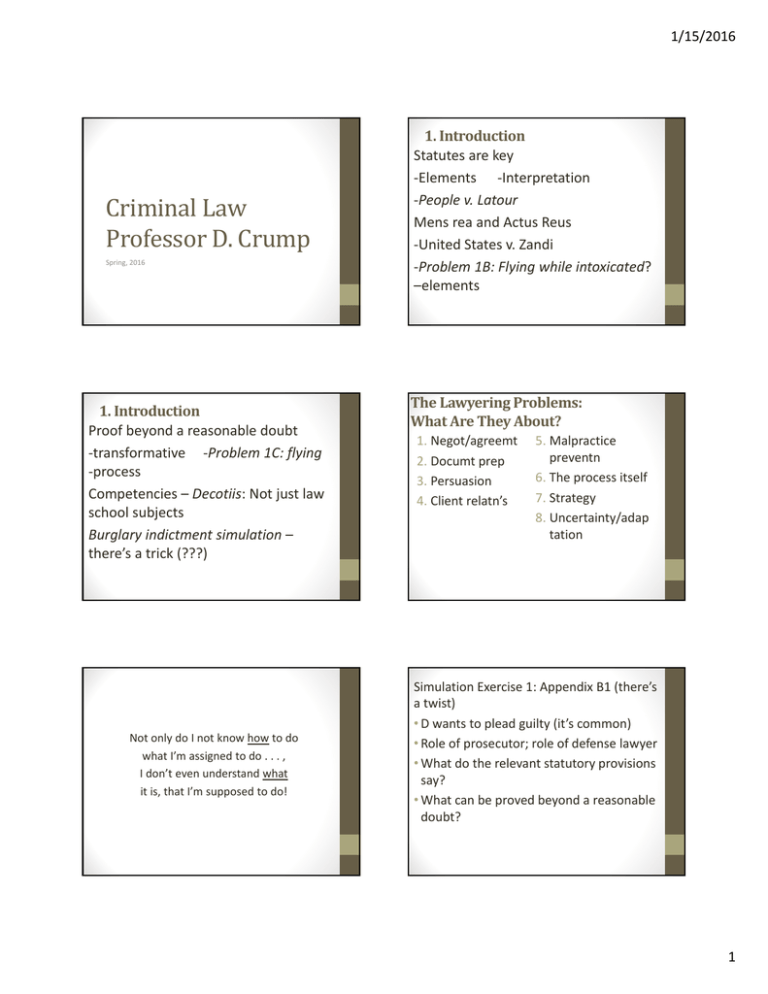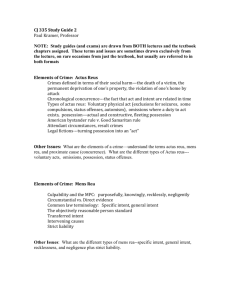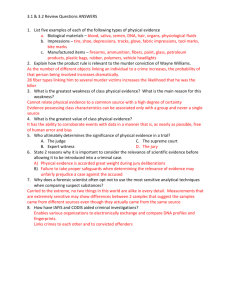
1/15/2016
CriminalLaw
ProfessorD.Crump
Spring, 2016
1.Introduction
Proof beyond a reasonable doubt
‐transformative ‐Problem 1C: flying ‐process
Competencies – Decotiis: Not just law school subjects
Burglary indictment simulation –
there’s a trick (???)
Not only do I not know how to do
what I’m assigned to do . . . ,
I don’t even understand what
it is, that I’m supposed to do! 1.Introduction
Statutes are key
‐Elements ‐Interpretation ‐People v. Latour
Mens rea and Actus Reus
‐United States v. Zandi
‐Problem 1B: Flying while intoxicated? –elements
TheLawyeringProblems:
WhatAreTheyAbout?
1. Negot/agreemt
2. Documt prep
3. Persuasion
4. Client relatn’s
5. Malpractice preventn
6. The process itself
7. Strategy
8. Uncertainty/adap
tation
Simulation Exercise 1: Appendix B1 (there’s a twist)
• D wants to plead guilty (it’s common)
• Role of prosecutor; role of defense lawyer
• What do the relevant statutory provisions say?
• What can be proved beyond a reasonable doubt?
1
1/15/2016
• Typical Penalties for the charged crime are given
• What would prosecutor offer on a plea???
• What should be the defense lawyer’s response???
A Homicide Map for the “Pennsylvania Pattern”
‐‐Murder: “Malice aforethought” (but not really)
‐‐First degree: premeditation, deliberation etc.
‐‐Second degree: other kinds
‐‐including “malignant heart” & felony murder
‐‐Voluntary manslaughter: passion killing
‐‐Involuntary manslaughter (incl. vehicular)
‐‐[Negligent homicide] ‐‐a bad pattern?
What are premeditation and deliberation?
‐‐Commonwealth v. Carroll: can be instant
‐‐People v. Anderson ‐‐Perez overrules (?)
‐‐Problem 2A: the I dare you to kill him murder
‐‐Conley: Charge confusion (bad)
Objectives—See syllabus topics
‐‐Main objective: to learn today’s criminal law
‐‐Other objectives—see handout
Class policies and Methods
‐‐the syllabus ‐‐the disclaimers (in syllabus)
‐‐class policies, in syllabus ‐‐exam method
‐‐compression effects ‐‐solutions
‐‐Biography of a Criminal Case ‐‐simulations
What is heat of passion? Problem 2B: Carroll
“Depraved” or “Malignant” Heart as Malice
‐‐unintentional murder ‐‐United States v. Fleming
Involuntary Manslaughter: recklessness?
‐‐distinguishing depraved heart murder (?!)
Criminally Negligent Homicide
‐‐distinguishing involuntary manslaughter?
‐‐Problem 2C: the thrill‐seeking skier
2
1/15/2016
Texas(modifiedMPC):
1. murder? 19.02
(b)(1): intent, knowl
(b)(2): intent, SBI
[2. vol. manslaughter?]
19.02(d): included in murder; reduces sentencing range
Tx.PC§ 6.03
intent
knowledge
recklessness
crim. negligence
[strict liability] Sentencereductioncharge
If D proves in the affirmative, by a preponderance of the ev., that he caused the death under the immediate influence of sudden passion arising from an adequate cause, you will so say by your verdict....
Texas(modifiedMPC):
3. [invol] mansl?
19.04: “recklessness”
4. crim. neg. hom?
19.05: “crim neg”
[5. capital murder = “murder plus”] Danshoots&killsVic.
1. wants to kill him
1a. aims carefully at him, not caring.
1b. wants to injure.
2. just heard, Vic stole his girlfriend
3. shoots at target, aware pedestrians frequently behind it
4. shoots at target, unaware of frequent pedestrians
[5. robs Vic & kills, execution style]
Therefore, if you find by the prepond...that Martinez caused the death of Cox [sudden passion adequate cause]..., verdict.
If you so find, you shall fix d’s sentence at any term of years from 2‐20.
“adequate cause” means.... [19.02(a)(1)]
“sudden passion” means....[19.02(a)(2)] 3
1/15/2016
If you do not so find by a preponderance, you shall consider the range of sentence of 5‐99 or life.
We, the jury, find that Martinez by a prepond. caused death under...[sudden pass., adequate cause], and fix his sentence at ____________________ [2‐20]. [Alternate form verdict:
5‐99 or life _________________
TwoTexasCases
‐‐typicality
1. Rivera v. State:
•Timotheo stabbed; Gilbert shot
•legal & factual sufficiency
•“parties” concept
TwoTexasCases
•4 kinds of murder:
ointent/cause death
ointent/cause ser. bod. inj.
oas party, intent/death
oas party, intent/SBI
•“application paragraph”
TwoTexasCases???
Martinez: stabbed more than 2 dozen times; claims defending vs. Martinez stabbed umpteen times; claims defending sex assault;
But expert: blood spatters inconsistent.
TwoTexasCases???
•claimed error: [invol.] manslaughter omitted.
•what’s a lesser included?
•what’s manslaughter?
•Why no error?
•what about “voluntary” manslaughter? TwoTexasCases:Notes(Supp.)
1. judges’ “politics”?
2. Rivera’s “application ¶”
3. Martinez: how use “sudden passion . . . adequate cause”?
4. does Martinez qualify?
5. [invol] manslaughter? 4
1/15/2016
TheFelonyMurderDoctrine:
ImpliedMalice
limits of fel murder
1. “dangerousness”?
a. “dangerous felony?”
b. “dangerous act”
2. merger‐‐a lesser included [homicidal] crime shouldn’t be used as predicate
TheFelonyMurderDoctrine:
ImpliedMalice
3. in furtherance
4. causation
a. “agency” approach‐‐only acts of D
b. proximate cause
c. broader cause (but‐for; “set in motion”)
• see Texas 19.02(b)(3) Roth&Sundby (Againstfel murder)
Crump (Defenseoffel murder
doctrine)
1. “patchwork” attempts to mitigate
2. most serious sanction shouldn’t be for accident
3. deterrence illogical
a. how deter unintended act?
b. felons won’t know the rule
4. transferred intent/ constructive malice: illogical
5. retributive purpose operates “regardless of culpability”
1. rational classificatn, grading: robbery w/death isn’t just a robbery.
2. condemnation: human life. condemnation “operates on the upright”‐‐
society, victim.
3. deterrence‐‐opponents’ assumptions
[4. other arguments]
[5. limits aren’t patchwork but related to purposes; every crime has limits] Crumparticleongood/badfelony
murderdefinition
Crumparticleongood/badfelony
murderdefinition
• biggest criticism of felony murder: separated from blameworthiness
• “Bad” ??? felony murder definition???: California
‐‐applies to “dangerous felonies.” Needn’t be dangerous act.
‐‐haphazard def’n of dangerous felonies.
‐‐liability / blameworthiness separated???
• “Good” felony murder defn’: Texas
‐‐not only requires felony and causation, but also
‐‐D must cause by act “clearly dangerous to human life”
‐‐liability / blameworthiness connected, with this law???
‐‐remaining issues: negligent felonies? co‐
party? 5
1/15/2016
If D proves in the affirmative, by a preponderance of the ev., that he caused the death under the immediate influence of sudden passion arising from an adequate cause....
Therefore, if you find by the prepond...that Martinez caused the death of Cox [by sudden passion / adequate cause]..., you shall say by verdict. “adequate cause” means.... [19.02(a)]
“sudden passion” means.... [19.02(a)]
3.ElementsofCrimes:Problems
Break this into elements:
“A person commits an offense if s(he) knowingly enters a private place on a Sunday with intent to defraud and manifests loud, raucous or belligerent behavior toward any person or animal while bearing a firearm on or about his/her person, unless the person is acquainted with any person who regularly inhabits the private place so entered.”
Imagine this municipal ordinance:
“. . . a person who keeps within the territory of the city any number of [list of animals], and who is not in the business of boarding animals, is guilty of a misdemeanor.”
•An unprovable offense. Why?
If you so find, you shall fix d’s sentence at any term of years from 2‐20. If you do not so find by a preponderance, you shall consider the range of sentence of 5‐99 or life.
We, the jury, find that Martinez by a prepond. caused death under…[sudden pass., adequate cause], and fix his sentence at [2‐20]. __
[Alternate form verdict: 5‐99 or life].__
CommonLawBurglary
…is breaking and entering into the dwelling house of another at night with intent to commit a felony therein.
WhatelementsinDWI?
• main statute, 49.04
• additional provisions
• the “drunk, drugged or sleepy” apparent “wheelchair pedestrian”
“Harassment”‐‐why hard to prosecute? 6
1/15/2016
Tx.P.C.§ 6.01:voluntaryact,
omission,possession
“actus reus” also includes: act, circumstances, result
what is actus reus for
∙ murder? § 19.02(a)(1)
∙ attempted murder? § 15.01
∙ felony murder? § 19.02(a)(3)
State v. Sowry
∙ actus reus? Argument contrary to holding?
Omission as actus reus
∙ There must be a duty
∙ Sources of duties
∙ Problem 3C (overdose; dumping)
Possession
∙ Is it an act? A status? A willing something?
∙ Constructive possession
∙ Zandi
Circumstancesarepartoftheactus
reus
Circumstancesarepartoftheactus
reus
Mens rea
• Proof—Problem 3E
• General /specific Intent: Kimes
(asslt officer)
• Variety of traditional mentes reae
• Model Penal Code
Harm is part of the actus reus
(death, for murder)
Causation is part of the actus reus
• But‐for or variations (proximate)
• Problem 3d (street racing)
Commonwealth v. Noel
• State has a better argument than appears
• Circumstances
7
1/15/2016
Fourmentalstates(actually,five)
• Purposefully (intentionally)
• Knowingly—subjective? Objective?
• Recklessly—note downward inclusiveness
• Criminally negligently (contrast ord. neg.)
• [strict liability]—note default mens rea
SimulationExercise3:Indictment
See Appendix B1, for the form & format
• Jurisdiction (county, state; after g. jury formed)
• On‐or‐about date
• All necessary elements of crime
• Identify certain elements (D; victim; manner & means
1. false stmt to obtain gambling license: mail fraud? COVERS: “artifice to (a) defraud or (b) obtain propty”
2. intentional damg to computer data owned by corporation. Computer fraud? COVERS “damage to individual” Remember: intent, knowledge, recklessness, crim. negligence
Illustrations:
∙ Problem 3F (bumped car)
∙ United States v. Lynch (archeo. resource)
∙ People v. Hall (thrill‐seeking skier)
Simulation Exercise 4: Court’s charge—
See Appendix B2, end, for the form & format
• Define the crime (our law provides)
• Application paragraph (therefore, if you find)
Thelogicofstatutes
• Syllogism—deductive logic
• Types
• Analogy—inductive logic
• Generalization or Induction—also inductive logic
• Examples, notes
• IRAC as applied to statutes
8
1/15/2016
Interpretingtheelements?
formalism
Instrumentalism
1. murder statute, construed by each
2. Douglas’s penumbra, Black’s no provision
natural law
positivism
1‐2. Iredell & Chase
3. right to define “meaning of universe”?
Bobbitt’s6Interp Modalities
1. const of death penalty
2. different interp of Bible?
3. which modalities superior/disfavored?
4.TheBurdenofProof
3. play upon words?
4. elements, defenses, & aff. defenses
5. passion killing in Tex.
6.‐7.
what should be element, defense, aff. def?
Bobbitt’s6Interp Modalities
• textual
• historical
• structural
• doctrinal
• prudential
• ethical
4.TheBurdenofProof
const req’mt/proof: Winship
What about an issue not an “element”?
1. Mullaney: passion negates malice
2. Patterson: passion independent of malice
BurdenofProofcont’d
1. Tex. P.C. 2.01: elements/exceptions
2. defense formulas, prosecution
3. examples
4. should court define? (Paulson)
5. can circumstantial ev. suffice?
9
1/15/2016
The“n”Controversy
The “n” controversy: how many guilty to be freed?
1. 1 ≤ n ≤ 1,000?
2. n skeptics
3. n & crime rate‐‐related?
4. does anacceptable n value exist?
5. if n affected by prejudices?
6. only better is better?
Costs/Erroneous/…
Costs/erroneous/acquittal: Langley case
1. critique jury (argument: acquittal was wrong‐‐or right?)
2. was this an “error”? what costs?
3. “reasonableness” depend on harmfulness / acquittal error?
Costs/Erroneous/…
Costs/erroneous/conviction
1. the protections
2. “We’re Sorry”: why didn’t protectns work?
3. costs/erroneous conv.
4. the ethical q: erroneous acquittal preferred?
5. real‐world ethics: err. acquittal not ethically superior?
Stogsdill v.State:hairevidence,
Kump’s evidence,etc.
DNA&Statistics
1. would DNA change Stogsdill? (sorry, but no)
2. the CSI effect: “where’s the DNA?”
3. experts needed to prove up DNA?
DNA&Statistics
4. what does “1 in a million” mean?
5. how good is DNA? (lab errors)
6. when DNA is powerful: product rule, Bayes’ Theorem
7. popular understanding of Bayes
1. critique? (deference to jury?)
2. cumulative, circumstantial?
3. TV: “motive, opportunity, means”
4. other questionable elements?
5. “manner & means unknown”?
10
1/15/2016
EyewitnessEvidence
1. “preferred”? why?
2. “better” than science/circumstantial?
3. serial crimes: law enforcemt
method?
4. experts on ID? factors? instructions?
Otherburdens (nottrialguilt
elements)
1. true defenses?
2. redraft: difficult elements, change to D’s defenses 3. sentencing
4. screening stages
5. presumptions?
5.Assault&RelatedOffenses
Notes 4‐5: different jurisdictions, multiple crimes
specific intent assaults, some states
ExpertsonID
Factors
1. forgetting curve
2. stress = distortion
3. assimilation
4. feedback
5. confidence ≠ accuracy
6. second‐ID transfer
7. cross‐racial
ProceduresInfluencingProofBurden
1. evidence: similar crimes
2. joinder/similar crimes
3. pretrial motions
4. confessions statute
5. corroboration as a proof element
5.Assault&RelatedOffenses
TX: 22.01 simple assault: elements
.021 agg assault—serious bod inj; high def’n
[attempted murder]
.04 injury/child—note, can be negligent
.05 deadly conduct—e.g., pointing firearm
.07 terroristic threat—what mental state?
11
1/15/2016
5.Assault&RelatedOffenses(cont.)
Stalking, TX 47.027
Harassment, TX 42.07(a)
Domestic violence
•mandatory arrest, special def’n, etc.
•Warren Moon’s case
5.Assault&RelatedOffenses(cont.)
mens rea
‐ does it attach only to sexual act?
‐ does it attach only to sexual act plus force?
‐ attach to sexual act; plus force, plus nonconsent?
• knowledge of nonconsent, recklessness, crim negligence?
• Reynolds v. State (Alaska: reckless, negligence?)
5.Assault&RelatedOffenses(cont.)
3. What mental state?
4. Is intent to do act enough, or must D know/intend nonconsent?
•Problem 5F (Kobe Bryant)
5.Assault&RelatedOffenses(cont.)
sexual assault (rape)
1. actus reus: force, etc.; nonconsent; sexual act
2. mens rea
5.Assault&RelatedOffenses(cont.)
TX 22.011 (a‐b) basic sexual asslt
1. (a) D (b) intent, knowl, (c) causes (d) penetratn (e) anus or sexual org etc. (f) w/out consent
2. What is “w/out consent”? Multiple definitions.
5.Assault&RelatedOffenses(cont.)
TX 22.011 sex asslt/child
[“strict liab”?]
22.021 agg sex asslt
[by threat SBI; DW]—Rucker v. State
[amendment changes Rucker]
12
1/15/2016
5.Assault&RelatedOffenses(cont.)
Other offenses: 20.03‐.04 kidnap; agg
kidnap
20.01(2) def’n of abduct
20.02 unlawful restraint
6.GeneralDefenses
4. law enforcement, § 9.51 when & to degree reas believes necess & reas believes valid
[deadly force] [civil liability]
5. resist/arrest, § 9.31(c)
• usually: NO! exception: unreas force, first
6. necessity, § 9.22, Commonwealth v. Leno—needle exchange
7. public duty, § 9.21
8. discipline, § 9.61‐62
Self‐defense
• Problem 6A, George Zimmerman
• Problem 6B, Hockey Dad
Defense/ third person
• People v. Randle, shooting after too‐
long beating
6.GeneralDefenses
1. self‐defense—see next slide
2. defense of another: “step into shoes” vs. [Tx. § 9.33:] reasonable belief—see next slide
3. defense/propty, § 9.41‐44 “when & to degree reas belief immed necess” [deadly force]
Self‐defense
TEX: when & to degree reas believes immed necess to protect agnst others use unlawful force‐‐objective std
(why?)
Deadly force restrictions
• Retreat rules, deadly force v. home/”castle” v. stand/ground
• “Provocation”
DuressandEntrapment
1. duress: Contento‐Pachon:
• “imminent death/SBI”
• TX: § 8.05 similar; affirmative defense
2. entrapment:
• Subjective v. objective approach
• TX: § 8.06, requires both:
• “induced” by “persuasion . . . likely to cause”
13
1/15/2016
InsanityDefinitions
1. M’Naghten: cognitive‐‐knowledge of act/wrong
2. “irresistible impulse”
3. Durham: “product” of “mental disease/defect” [rejected]
•responsibility v. determinism
•strategy (deterrence) v. determinism
•meaning of “product”?
Moreinsanitydefinitions
4.
Freeman: MPC
criticisms of M’Naghten
“as a result/mental defect, lacks subst
capacity/appreciate wrongfulness or conform conduct” [since J. Hinckley, widely
rejected]
5. abolition; guilty but insane
6. TX: § 8.01, M’Naghten‐like affirmative
defense
• Problem 6F: stoning of children
Intoxication
• Mistake/fact: Tx § 8.02 reas belief negates mens rea
•unless strict liability: State v. Perez, sex asslt / child
• mistake/law: Tx § 8.03 ignorance no defense, but aff defense: reas belief + written documt, authoritative
United States v. Albertini, protester, ct. op. later reversed
Insanitycont’d
• compulsive gambling as defense/robbery?
• intoxication, alcoholism‐related?
• severe environmental deprivation (“rotten social bkground defense”)?
• clinical depression, postpartum onset?
• PTSD; rape trauma syndrome?
• XYY syndrome?
• “affluenza?”
Intoxication
Intoxication: “no defense” Tx § 8.04
7.TheftandRelatedOffenses
I. Larceny
1. property 2. of another 3. caption 4. asportation 5. intent/deprive: People v. Meyer, coat chain
II. Larceny by trick
1. poss’n obtained 2. trick, not caption: King v. Pear, horse
14
1/15/2016
7.TheftandRelatedOffenses
III. False pretenses
1. title obtained 2. by deception: People v. Phebus, price tag
IV. Embezzlement
1. fraudulent 2. appropriation of
3. propty/another 4. by entrusted: Problem 7C, employee‐‐$
ConsolidationofTheftOffenses
1. the problem—Problem 7D, baseball ticket checks
2. the solution
Tx. 31.03:
1. [def’n] exercise control
2. property [def’n]
3. intent to
4. deprive [defn: perm or extended]
5. the owner
6. w/out effective consent [defined]
ReceivingStolenProperty
1. defined as theft
2. why?
3. importance
FederalCrimes
Bank robbery (actually, theft): broad coverage?
• Bell v. United States, stolen check
Mail / wire fraud
• Again, broad coverage
• But generally limited to propty
• Honest services—Skilling; if propty taken
• What about fraudulently getting gambling license?
Remainingissues;theft/services
Remaining issues
• Theft/services, TX § 31.04; services defined.
• temporary deprivation? UUMV, §
31.07
• forgery, § 32.21
• check offense, § 32.41(a)(b)
• related offenses
ReceivingStolenProperty
4. difficulties; solutions
a. proof/knowledge
b. corroboration
c. similar transactions
d. record keeping
e. law enf. Stings?
15
1/15/2016
OtherIssues
• Belief about right to keep: Problem 7H (bank error)
• Theft/services, TX § 31.04; services defined. Computer offenses: Note 5, United States v. Drew (MySpace)
• Identity theft
8.“Theft‐Plus”Offenses
• Extortion: TX, it’s theft
• Burglary
1. enters 2. bldg or portion 3. not open/public 4. intent 5. entry or: concealment; & 6. obj crime
•Reconsider State v. Bates (indicted burglary, in appendix)
1. Utilitarianism & slavery‐‐slave owners wd like.
• But Kantianism opposes; why?
2. Utilitarianism & vulnerable minorities:
• How treat ADA, confiscation of amusemt
park?
3. Kant: conflicting categorical impo?
• What if performance of promise illegal?
4. Kant: must you tell truth to terrorist (prey in closet?)
• or: K bankrupts promisor w/negligible benefit
Problem 9B: organ donor, commute death sentence? 8.“Theft‐Plus”Offenses
• Robbery
1. course/theft
2. intent/control
3. reckless inj/knowing threat
•State v. Holmes (keeping jewels); Problem 8A (carjack)
• Agg robbery: SBI/DW/etc.
9.Sentencing
Ethical Philosophies
Teleology = nature & purpose
•consequentialism
•Bentham, Mill: utilitarianism; economics
Deontology = non‐purposive
•(not cost/benefit)
•Kant : imitation principle, categorical imperative
GeneralJustificationsofSentence
1. deterrence: general or specific (Beccaria)
2. incapacitation (J.Q. Wilson)
3. rehabilitation (Medical model?)
4. retribution: “justice” (or “revenge”?)(Kant)
a. proportionality to blameworthiness (Kant)
b. victims, upright people, etc. (Durkheim)
c. uniformity
Problem 9C (long sentences to stop crime? 3
16
1/15/2016
UnitedStatesv.Bergman
‐‐4 months/prison
‐‐the “4 factors”: rehabilitation, deterrence, incapacitation, retribution
‐‐probation or prison?
‐‐“measuring” the sentence
1. goal inconsistencies
2. “have you ever . . . prison? / nursing home?”
3. “disparity”
SentenceOptions
UnitedStatesv.Olis
‐‐original 24‐year sentence under (mandatory) guidelines
‐‐reduced to 6 years; financial loss, huge
‐‐the 4 factors: rehabilitation, deterrence, incapacitation, retribution
‐‐measuring the sentence? Contrast to Bergman?
SentenceOptions
1. Probation: conditions; usual v. additional confinement; community service
“Community corrections”
Eligibility; nonqualifying offenses and circumstances
Problem 9F (sign)
Revocation—preponderance; no jury; indictment, or
crime required; Problem 9G (polygraph)
2. Fines, restitution, diversion—State v. Curry
3. Incarceration
parole issues; parole limits: McDermott
v. McDonald
(due process—but very little)
enhancements, e.g. Tx. 12.42(c) (1 prior)
Tx. 12.42(d) (2 priors)
4. Civil remedies
SentencingHearing
Tx, can be judge, or
1. jury election: when elect? good law?
2. the process: jury gets relevant evid
Including crim record; character; and
Unadjudicated offenses
Consider Williams v. N.Y. (broad)
SentencingHearing
Federal: judge sentences
Fed j must get a PSI
Should D submit to interview?
“hearing”: can be papers only? D can
object in writing; may use affidavits
17
1/15/2016
SentencingHearingcont’d
1. broad‐range discretn
[indeterminate sentence]
2. determinate
a. mandatory?
b. Intermediate?
narrowed range; factors determine;
guidelines only, etc.
c. charge, bargaining, parole too?
TheFederalSentenceGuidelines
1. base offense level 2. relevant conduct
3. specific offense characteristics
4. adjustments
a. victim‐related b. role in the offense
c. obstruction
d. multiple counts
e. acceptance of responsibility
5. criminal history category
6. sentencing table
7. departure 8. probation; mandatory max/min
Simulations10‐12
Simulation Exercise 10: sentencing in robbery/rape case
Simulation Exercise 11: Bubba shot the Juke Box
1. Bubba shot the juke box; $ 10,000 loss, prior conviction 3 years—figuring the sentence
Base offense level; relevant conduct; specific offense characteristics; adjustments; criminal history category; sentencing table; departure; probation or mandatory minimum/maximum
IssuesinDeterminateSentencing
1. complexity/confusion 2. discretionary better?
3. distortion and cost 4. plea bargaining
5. right to jury trial 6. sentencing goals
8. preserving the right level/discretion
9. hardest cases: conflicting goals
GuidelineInterpretation
(What’s“obstruction”?What’sa“manager”?)
Preponderance std—why? Due process? Rt
to jury? why?
Calculatn in Geevers case:
1. no rules/evi—but note that it’s advisory only
4. degree/precision
2. tables
5. is this “preponderance”?
3. estimate 6. proportionality?
Simulations10‐12
Simulation Exercise 11 (cont): Bubba shot the Juke Box
2. Bubba also shoots & kills bar owner; voluntary mansl.
3. Critiquing guidelines vs. discretion
Simulation Exercise 12: Smith PSI
18
1/15/2016
Greggv.Georgia
CapitalMurder,§ 19.03
Death penalty goals of deterrence, justice
1. incapacitation, too?
2. should rehabilitation be a factor?
3. arguments against?
“murder‐plus”
[2/3 are robbery‐murders]
sentence hearing
relevant evid except excluded/Constitution
3 questions: Violence, Anticipation, Mitigation
Burden/proof
DeathPenalty
Against death p:
1. barbarism?
2. innocence errors?
3. causes murders?
4. race discrim?
5. blameworthiness errors?
Pro death p:
1. deterrence?
2. incapacitation?
3. justice?
10.Inchoate(Preparatory)Offenses
b.
sufficient act—United States v. Williamson,
attempted assault?
(1) substantial step;
(2) more than prep; (3) others
Tx: § 15.01 (more than mere preparation)
10.Inchoate(Preparatory)Offenses
Attempt
Four types
try & fail, interrupt, mistake, desistance
Elements:
a. specific intent—Problem 10A (bottle)
Attempt“defenses”
1. renunciation
•voluntary, complete
•avoid/commission
19
1/15/2016
Attempt“defenses”
2.
impossibility
a. “factual”—NO
b. “false legal”—NO
c. true legal—YES
d. inherent‐‐?—Problem 10B (HIV)
Conspiracy
1. 2+ people, agreemt, purpose/intent/promote, felony/crime, overt act—State v. Pacheo
(deputy murder plan)
2. agreemt: how formal? To do what?—
Falcone & Direct Sales
3. intent to promote
11.VicariousLiability
(MultipleParties)
Vicarious Liability ‐ Federal
[guilt based on acts of another]
1. usual rules: aid & abet or aid & encourage
CriminalInstruments
• § 16.01—rare if ever?
• solicitation, § 15.03—
•special corroboration reqmt
•Ganesan v. State (murder solicitation)
Conspiracy
4. mens rea: is knowlg enough?
5. overt act: can it be innocent (noncrime)?
6. Tx § 15.02—Problem 10E (ABCD distributing heroin)
7. renunciation
11.VicariousLiability
(MultipleParties)
2. Pinkerton liability; also, TX 7.02(b)
a. based on consp
b. but liab is for completed crime
c. agency basis
d. scope, furtherance e. foreseeability
‐‐Problem 11A: prostitution; extent?
20
1/15/2016
MultipleParties
1. common l: principal 1st, 2d; accessory before, after
2. federal: aid & abet
•how much aid?—People v. Moore (firearm encouragemt)
4. mens rea?
5. Texas: “parties”—next slide
Texas“Parties”
1. Tx. 7.02(a)
a. culpable mental, nonresponsible
agent
b. intent/promote, aid, encourage, etc.
• Rivera v. State (shoot/stab); Prob. 11B (map)
c. duty/prevent, etc.
2. 702(b) – Like Pinkerton
RICOElements
3. Post‐crime liability: hindering, 38.05a; tampering, 36.05
4. Corporate: 7.22‐24, for usual felony, reckless toleration, high managerial agent; diligence defense
5. Individuals: “throwdown prisoners”?
‐‐civil (treble damages) & criminal
1. assoc/enterprise
2. interstate comm
3. conduct/participate 4. enterprise affairs
5. pattern/racketeering, meaning—
a. at least 2
b. named crimes
c. w/in 10 yr.
d. Continuous
e. related
Sedima v. Imrex (inflated)
12.ContrabandOffenses;Terrorism
RICO forfeiture: interest acquired
or maintained in violatn—Note 2 on DeFries case
controlled substances: Tx.
1. schedules 5. Manufacture (def’n)
2. registration 6. Delivery (def’n)
3. precursor reports 7. Possn w/ intent (def)
4. penalty groups 8. Possession
1. e.g., heroin ‐‐Problem 12B (roofie)
1A. LSD ‐‐Webb v. State (possn?)
2. e.g., psylocibin
3. e.g., barbiturates
4. e.g., “Robo”
21
1/15/2016
Possession
Terrorism
1. “actual care, custody, control, mgmt”
2. mens rea: intent/knowl
3. evidence sufficiency
a. personal possession
[b. negate others?]
c. close proximity
d. recent use
e. occupancy
• The enactments
• Amendments
• Problem 12H, bomb advice
• Not covered: combatants, etc.
13.Criminalization:Legitimacy
1.
notice? (fair warning)—Rogers v. Tennessee; People v. Kevorkian
2. Rule of Lenity—Note 4, United States v. Sykes, armed career criminal
3.
definition?: “reas people not have to guess”
a.
citizens, complying
b.
law enf, arrest
c.
judge/jury, adjudicate—Lanzetta
(gangster); Nash (matter of degree; how close?)
14.Perspectives
4.
Ex post facto:
Common law crime?
Construe strictly against govt?
Can court interpret? evolve?
Crime, harm—& justification: notes at 8‐10
Problem 1A (helmet law; conflictg
argumts)
Non‐criminalRemediescont’d.
Also: non‐criminal remedies
I. forfeiture: (a) basis & extent; (b) is it really civil
II. licensing
III. other—e.g., precursors
IV. preventive detention/civil commitment
1. architecture
2. behavior modification
3. transportation
4. pvt security and suits
5. civil/admin penalties
6. police prevention
7. mediation; confrontation
8. the economy; societal
9. quality‐of‐life
10. social spending
11. decriminalization
22
1/15/2016
Victims’/Survivors’Issues
A. compensation
B. notice, information, warning, protection
C. participation
D. justice; resolution
E. solidarity; understanding
F. crime defn; process; humane treatment
G. official liability
H. offender confrontation
Settlement
1. the case against settlement
2. the case for settlement
(Does the case against settlement depend on an unspoken assumption that conviction in a single trial by a single jury is absolutely accurate or universally authoritative, & conviction by plea of guilty is not? Is it true?)
WhySettlement?
12 judges, 30,000 indictmts
= less than 5 min. per case at most.
• “solutions”?
1. screening; selectivity?
2. more courts?
3. decriminalization? diversion?
4. reform (radically alter jury trials)?
5. regard settlement as acceptable?
CourthouseLanguageabout
GuiltyPleas
“They offered that tush hog Billy Ray Bonebreaker a dime, but he never sensed how much of a whale he was, and so he rolled the dice & got popped for ninety‐nine rodeos.”
‐‐what does this mean about trials versus guilty pleas?
Gross/Seyverud’s Analysis
1.
2.
3.
4.
5.
6.
pty.
7.
8.
9.
10. jury trial = scarce resource.
not to be wasted.
far scarcer than believed.
settlement = norm. 97 %?
adjudicatn = rare xceptn.
usually adjudicatn = disaster for at least 1 why so few jury trials?
why does a trial result?
reform?
yr role as “trial” lawyer?
DebatableIssues
• should plea offers be the same for all parties(?)
• executive discretion—Newman v. United States
• “choose one to plead guilty—either one”(?)
• “only if all plead guilty”(?)
• how to prevent guilty pleas that are wrong(?)
• attempts to outlaw/avoid plea bargaining(?)
23
1/15/2016
GuiltyPleaProcess
• Fed. R. Crim. P. 11; Tex. Code Crim. P.
1. written waiver
2. written approval
3. Evidence
4. Admonitions
5. Voluntariness
• Tullos v. State:
• indictmt=threatened, but stipulation=stabbed.
• 2d case, admonition defective.
24





